If you thought banana peels were only good for slipping on or throwing away, think again. These humble fruit skins are actually a hidden gem when it comes to gardening.
Packed with nutrients like potassium, phosphorus, and calcium, banana peels can do wonders for your garden’s health and productivity.
In this gardening guide, we’ll explore the various ways you can harness the power of banana peels to transform your garden into a thriving oasis.
From making nutrient-rich compost to creating natural pest repellents, we’ll reveal the secret tips and tricks that will make your plants flourish.
So, whether you’re a seasoned gardener or just starting out, get ready to unlock the full potential of banana peels and take your gardening skills to the next level.
Don’t toss those peels in the trash – they hold the key to a luscious and bountiful garden!
The Benefits Of Using Banana Peels In The Garden
Banana peels may seem like just another kitchen waste, but they are actually a treasure trove of benefits when it comes to gardening.
These peels contain essential nutrients and organic compounds that can boost your garden’s health and productivity.
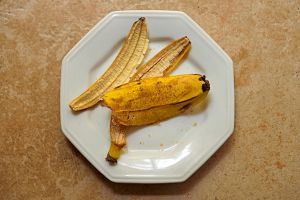
Apart from their nutrient content, banana peels also offer other advantages in the garden. They act as a natural fertilizer, providing slow-release nutrients to the soil, and they can also help deter pests.
The organic compounds present in banana peels act as natural repellents, keeping common garden pests at bay.
Additionally, banana peels can be used to make nutrient-rich compost, enriching the soil and promoting long-term soil health. You can learn here how to test soil health the way pioneers did.
With all these benefits, it’s no wonder that banana peels are becoming a popular choice among gardeners looking for natural and sustainable gardening solutions.
How To Prepare And Store Banana Peels For Garden Use
Using banana peels in the garden is simple and easy, but it’s important to know how to prepare and store them properly for optimal results.
The first step is to collect banana peels after eating the fruit. It’s best to use organic bananas to avoid any potential pesticide residues.
Once you have collected the peels, rinse them thoroughly to remove any dirt or debris. You can also gently scrape off any remaining fruit flesh from the peels.
After cleaning the peels, you have a few options for storing them. If you plan to use the peels immediately, you can keep them in a sealed container or bag in the refrigerator. This will help preserve their freshness and prevent any unpleasant odors.
Alternatively, you can also dry the peels for future use. To do this, simply lay the peels out in a single layer on a tray or baking sheet and let them air dry for a few days. Once dry, you can store them in an airtight container in a cool, dark place.
Ways To Use Banana Peels As A Natural Fertilizer
Using banana peels as a natural fertilizer is one of the most popular ways to harness their benefits in the garden. There are several ways you can incorporate banana peels into your fertilizing routine, depending on your plants’ needs and your gardening preferences.
Related: How To Make Comfrey Fertilizer For An Extended Harvest
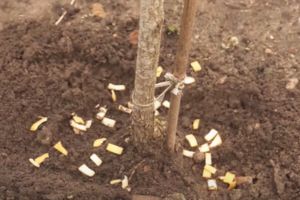 One straightforward method is to bury the banana peels directly in the soil around your plants. Simply dig a small hole near the base of the plant, cut the peel into small pieces, place them inside the hole, and cover it with soil. As the peel decomposes, it will release its nutrients slowly, providing a steady supply of nourishment to the plant roots.
One straightforward method is to bury the banana peels directly in the soil around your plants. Simply dig a small hole near the base of the plant, cut the peel into small pieces, place them inside the hole, and cover it with soil. As the peel decomposes, it will release its nutrients slowly, providing a steady supply of nourishment to the plant roots.
Another option is to create a banana peel tea. To make this natural fertilizer, soak a few banana peels in a bucket of water for a few days. The water will gradually absorb the nutrients from the peels, creating a nutrient-rich liquid fertilizer.
You can then use this banana peel tea to water your plants or spray it directly on the leaves. This method is particularly beneficial for plants that prefer foliar feeding, as the nutrients are absorbed directly through the leaves.
Using Banana Peels To Deter Pests And Diseases In The Garden
In addition to their fertilizing properties, banana peels can also help deter pests and diseases in the garden. The organic compounds present in the peels act as natural repellents, keeping common garden pests at bay.
For example, placing banana peels around plants can help repel aphids, slugs, and snails, which are notorious for damaging crops. You can either lay the peels on the soil surface or bury them slightly around the plants.
Related: Why You Should Put Plastic Forks In Your Vegetable Garden
Banana peels can also help prevent fungal diseases like powdery mildew and black spot. To use them as a natural fungicide, chop the peels into small pieces and bury them in the soil around the affected plants.
As the peels decompose, they release compounds that inhibit the growth of fungal spores, reducing the risk of disease.
Composting Banana Peels For Long-Term Soil Health
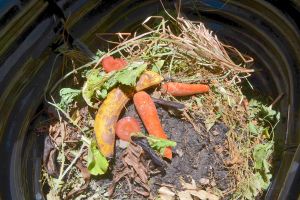 Composting banana peels is an excellent way to utilize their nutrients and promote long-term soil health.
Composting banana peels is an excellent way to utilize their nutrients and promote long-term soil health.
Compost is often referred to as “black gold” for gardeners.
It enriches the soil and improves its structure, fertility, and moisture retention.
Banana peels make a valuable addition to compost piles, providing a rich source of organic matter and essential nutrients.
To compost banana peels, simply chop them into small pieces to speed up the decomposition process. You can then add the peels to your compost bin or pile, along with other organic materials like leaves, grass clippings, and kitchen scraps
It’s important to maintain a balance of green and brown materials in your compost, so make sure to layer the banana peels with carbon-rich materials like dried leaves or shredded paper. Turn the compost regularly to ensure proper aeration and moisture levels.
Over time, the banana peels will break down, adding valuable nutrients to the compost and creating nutrient-rich compost that can be used to amend the soil in your garden beds.
DIY Banana Peel Fertilizer Recipe
Different plants have varying nutrient requirements, and you can customize your banana peel fertilizer recipes to cater to their specific needs.
Ingredients:
- 5 banana peels
- 1 gallon of water
Instructions:
- Chop the banana peels into small pieces.
- Place the peels in a gallon of water and let them soak for at least 24 hours.
- Strain out the peels and use the banana peel-infused water to water your plants.
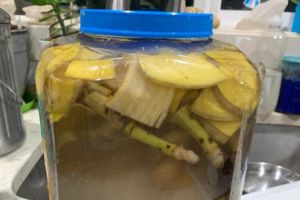
This all-purpose banana peel fertilizer can be used for a wide range of plants, providing a balanced nutrient boost to support their overall growth and development.
Tomatoes and peppers are heavy feeders, requiring ample nutrients for optimal fruit production.
This banana peel fertilizer recipe is specially formulated to provide the extra boost these plants need.
For more helpful information about growing a vegetable garden that will keep you and your family well fed, check out this guide on how to make a year-round self-sustaining garden.
Flowering plants, such as roses, marigolds, and petunias, also benefit from a nutrient-rich diet. This banana peel fertilizer recipe will help promote vibrant blooms and healthy foliage.
Planting marigolds around your vegetable garden will help deter deer and some destructive bugs which loathe the smell these hardy flowers emit.
Other Creative Uses For Banana Peels In Gardening
Apart from their role as natural fertilizers and pest repellents, banana peels have other creative uses in gardening. One interesting use is as a seed-starting pot.
By cutting a small section of banana peel and filling it with soil, you can create a biodegradable pot for starting seeds.
Once the seedlings are ready to be transplanted, simply plant the entire pot into the ground, allowing the peel to decompose and provide nutrients to the young plants.
Banana peels can also be used as a natural polish for plant leaves. Gently rubbing the inside of a banana peel on the leaves can help remove dust and leave behind a natural shine.
This method is particularly useful for plants with large, smooth leaves, such as philodendrons or rubber plants.
In conclusion, don’t let those banana peels go to waste! Instead, use them to boost your garden’s health and productivity.
With their nutrient-rich composition and natural repellent properties, banana peels are a valuable resource for any gardener.
From fertilizing your plants to deterring pests and improving soil health, the possibilities are endless.
So, the next time you enjoy a banana, remember the hidden potential of its peel and give your garden the natural boost it deserves.
You may also like:
 How The War In Europe Will Affect The US Economy
How The War In Europe Will Affect The US Economy
If You See This Plant In Your Backyard, Don’t Step On It (Video)
7 Mistakes To Avoid When Harvesting Rain Water

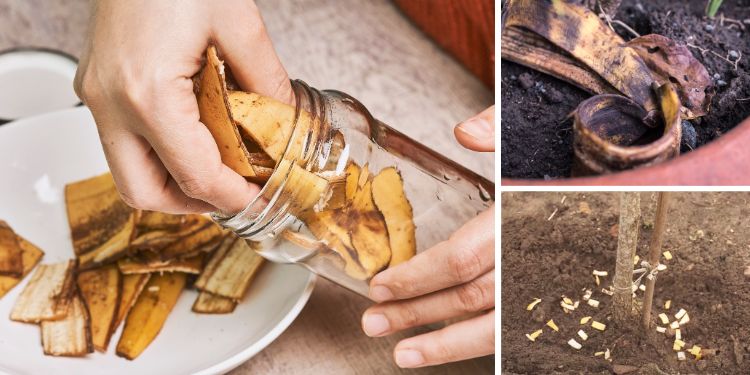




















Very interesting.Well done.
Banana peel water is why I have impressive plants. I even put other fruits peels in sometimes. Let’em soak a few days.
I’ve used banana peels fresh or dried along with egg shells in my garden for years. Egg shells to discourage snails and a whole egg or crushed shells under each tomato or pepper plant to help prevent blossom end rot.
Old bananas or peels are the perfect pick me up for plants as they begin to blossom or set fruits. Also excellent food for my roses. I add peices in the soil around plants and make a special tea of banana peels and crushed egg shells to feed when transplanting or when plants begin to bloom. I have a gallon container of it sitting in the laundry room ready to go to the garden today.
Also when I’m wanting to root cuttings, I slice up a very ripe banana and stick the cuttings into the banana.
Also when I’m starting roses from seed I use over ripe banana mixed in potting soil as a medium for seed starting. I have 100 each of 3 colors of roses sprouting to grow out and sell next year. I could sell the sprouts for $1 or $2 this year or $6 to $10 each next year. Add $5 to $10 per year for each year after that. Best sellers are 1 or 2 year old plants. I start them in small plastic pots. Repotting each 6 months while in a greenhouse. Or yearly for larger plants. In pots makes handling easier for me. I buy cheap thin commercial greenhouse pots for those projects. Purchases of 200 or more are very inexpensive. Cheap grow out tents or “tunnels” keep it clean and easy. Bananas for sprouting come from grocery store discounted or disposed of over ripe fruit. The local paleteria – ice cream shop gives me banana peels from their banana splits.
I get restaurant used coffee grounds for added nitrogen for green growth. Dry it out so there is no mold and mix it into soil at planting time. Excess goes into the compost piles.
When I’m preparing fruit to eat or can all peeling, trimmings, and seeds go in the compost. Many of my parents fruit trees came from things growing in their compost pile. I’ve been learning to graft trees using things growing in the compost. Replacement tomatoes and other things sometimes came from the compost as well. It is a damp, warm, alive place. My best fishing worms come from around the edges of the compost pile also.
My compost pile gets bags of Ieaves and grass clippings from yards I’m pretty sure aren’t sprayed with chemicals. In the desert I don’t grow a lot of grass. It’s a waste of precious water. A friend here has two tiny grassy areas. Those trimmings are mulch for the strawberries. It helps improve the poor soil and helps hold in precious moisture.
I also raise chickens and rabbits. Both provide good manure. Chicken dropping are too “hot” fresh so must be composted. Rabbit droppings are “cold” so can be used fresh. They are also high nitrogen so great for quick green growth.
Where I’m clearing new ground I plant a mix of dikon radishes and pinto beans. The deep dikon roots help break up the hard clay and rocks they draw nutrients from deep in the soil. I leave most of them to rot in place over the winter. It really helps make the soil usable the next spring. The beans fix nitrogen in the soil. I harvest some as green beans and the rest as dry beans in fall. I turn the bean plants under either in the fall or early in spring while its still too cool to plant. By planting time the hard clay is easier to work and the soil has been enriched.
I was always composting the banana peels. Now will try this fertilizer method, thanks.
You are PRIORITY EXAMPLE NUMBER 1 of why they’re are no conservative movies in Hollywood. I rest my case.
Yeah they all left for better places and left you pervert pedophiles behind, dude!
Probably attract black bears…no thanks
Bear skins/furs make fine rugs and wall hangings. I made a hat band with the claws (and then someone stole it). I don’t eat the meat, but if you had the time, you could barbeque up some greasy dog food for Fido.
Taco you are really a crazy possessed banana nut job. I think my cousin Lisa Blake can kick your lame banana butt any day of the week, jerk!
You really sound like a lunatic off your meds.
What is your problem, boy????
I put banana peels under my 12 tomato plants one year.
The local racoon population thought they were great. They overturned all of the plants except one and at the peels!
That won’t happen if you get a watchdog.
Kathleen Kennedy is why 1Timothy2 comes to mind.
NO WOMAN should ever be in any position of power, ever.
Everything they do turns out badly.
Fun fact: Did you know that Bananas are radioactive?
Fun fact #2: banana peels can take as long as 5 years to fully decompose.
Fun fact #3: If you are on a low sodium diet, you are supposed to avoid bananas.
I’ve been using bananas and crushed/ground eggshells in my garden for years.
Another top tip for bananas is, if you have any that are over ripe (or even ripe) place the whole unopened banana on the soil, preferably under leaves or out of sight of birds.
Worms will be attracted to it and then consume it over a week or three… The benefits of this is that the worm population will explode which in turn creates very fertile and renewed soil as the worms get busy in the soil once the banana has been eaten.
Good article, very bad string of off topic replies. This is not what I expect when i visit this page.
New to this site, huh? LOL
Amen to that!
Um, yeah. No. Your 1/2 inch has gone flaccid.
I’d like a piece of you any day, bubba.
Ramajama and me are really good buddy’s. We like to see you all squeal in the comments.
Man I did not know how crazy a topic on bananas could be insulting to preppers.
You could say that people have gone bananas………………..
LOL!!! Good one!
What Happens If You Put Banana Peels In Your Garden?
Monkeys show up and trash your garden. LOL
Actually this is a idea I’ve never thought of. I put fish carcasses, after I filet them, into the garden (just like the Indians did). I’m gonna try it. I’ll first try it with my Tomato plants.
I’ll pray for you……
like so many word s of filth and discuss
if you put garbage in your garden you will get garbage out of it
be carefull the kind of compost you select for growing
not everything creates a good out come
research the compositions so you dont end up with the trash from the filth of the streets of scum and perversion
Word can and do have many meanings
so be selective
as some of the discuss above , be selective
you cannot take out the trash once you let it in the door of your garden
create stops , individualize the piles so you know what is good and what is bad
You put them down as booby traps. Perp trys to steal your produce….they slip,fall and bust thier a**.
Someone watched Saturday Morning cartoons as a kid.
The travel places you shared are very good and very useful to me, I will often visit your articles to gain more knowledge.
They really boost the potassium and help balance my compost. I also dry some peels and grind them into powder for fertilizing my rose bushes. Layering well avoids odors too. Thanks for the reminder!
How simple and exact this driving directions software is to use will astound you. With its help, I was able to be at my destination far faster.